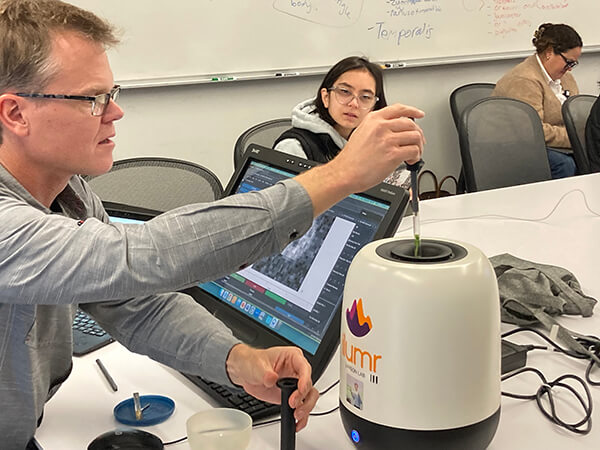A Tabletop MRI Enhances In-Classroom Learning for MSBI Students
 Peder Larson, PhD, teaches an annual course – Principles of MRI – to students in the Master of Science in Biomedical Imaging (MSBI) program. The course illuminates the physics behind MRI scanners, and this year includes a new tool for hands-on learning. In Larson’s classroom on the second floor of Mission Hall, with Koret Quad visible out the window, students have on their table a machine that vaguely resembles a rice cooker or a speaker about to throw down some serious bass.
Peder Larson, PhD, teaches an annual course – Principles of MRI – to students in the Master of Science in Biomedical Imaging (MSBI) program. The course illuminates the physics behind MRI scanners, and this year includes a new tool for hands-on learning. In Larson’s classroom on the second floor of Mission Hall, with Koret Quad visible out the window, students have on their table a machine that vaguely resembles a rice cooker or a speaker about to throw down some serious bass.
It's a tabletop MRI scanner, the Ilumr from Resonint, weighing about as much as a toddler, and it enables students to investigate the physics of MRI technology. Unlike MRI machines in clinical and research settings, which require special shielding, cooling systems, and weigh between five and 40 tons, this portable device offers an unparalleled opportunity for exploration. Students can freely manipulate imaging parameters, observe the effects of different techniques, and even induce artifacts to gain a deeper understanding of the underlying principles.

Larson's classes have taken on a playful yet informative tone, with everyday objects becoming subjects of MRI scans. From juicy blackberries to crunchy cauliflower florets, students image a variety of samples, learning about signal intensity, contrast, and spatial resolution. As the machine softly whirrs like a gentle air conditioner with occasional beeps, students witness the effects of motion artifacts by gently wiggling the sample tube during a scan, creating intriguing "ghost" images, or drop a metal contaminant, either steel or brass, into the sample tube to show how signal is destroyed and how artifacts pile up in the image.
Larson is thankful for the department’s investment in this important teaching resource, “This tabletop MRI provides hands-on experience in the classroom setting and fosters a deeper understanding of the technology and its underlying physics in our next generation of imaging specialists.”
